Written by Lynn
From Merida we signed up for a 4 day tour of an area called Los Llanos in the Amazonian basin of Venezuela. November is just the beginning of the dry season in this area. Los Llanos itself is a vast flatland covering about 1/3 of all of the land mass of Venezuela and is sparsely populated. It´s main source of revenue is the fact that it feeds about 5million of Venezuela´s 6.5 million cows. In the wet months it is almost entirely under
populated. It´s main source of revenue is the fact that it feeds about 5million of Venezuela´s 6.5 million cows. In the wet months it is almost entirely under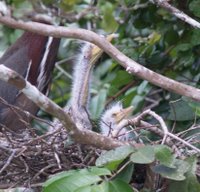 water, and in the dry months can become almost completely parched with only a few bodies of standing water. The time of year we went was just the beginning of their ¨tourist season¨which lasts from about November 15 until March when the rains start again. Later on in the dry season it is much easier to see
water, and in the dry months can become almost completely parched with only a few bodies of standing water. The time of year we went was just the beginning of their ¨tourist season¨which lasts from about November 15 until March when the rains start again. Later on in the dry season it is much easier to see  wildlife (the main reason for visiting Los LLanos) as they congregate around the rapidly diminishing pools.
wildlife (the main reason for visiting Los LLanos) as they congregate around the rapidly diminishing pools.
It´s a 12 hour ride from Merida sitting sideways in a all wheel drive vehicle as it crosses the spine of the Andes mountain range. A combination of very bendy roads, fast driving and altitude changes make for a slightly nauseating ride for the first 4-5 hours. The last few hours of the ride are on very muddy, rutted roads to get to the camp where we stay. The camp itself is quite rudimentary and run by a local farming family. There are a series of huts with several hammocks in each and a shower/bathroom area as well as a kitchen. There is no refrigeration and each tour group brings in its own food in from the outside. By the time we get there it is too dark to really appreciate our surroundings, except for the remarkable numbers of crickets, grasshoppers and various bugs that are attracted to the lights of the camp. Luckily, mosquito numbers are at a minimum (at least in comparison to Algonquin park in May, which is our set standard).
all wheel drive vehicle as it crosses the spine of the Andes mountain range. A combination of very bendy roads, fast driving and altitude changes make for a slightly nauseating ride for the first 4-5 hours. The last few hours of the ride are on very muddy, rutted roads to get to the camp where we stay. The camp itself is quite rudimentary and run by a local farming family. There are a series of huts with several hammocks in each and a shower/bathroom area as well as a kitchen. There is no refrigeration and each tour group brings in its own food in from the outside. By the time we get there it is too dark to really appreciate our surroundings, except for the remarkable numbers of crickets, grasshoppers and various bugs that are attracted to the lights of the camp. Luckily, mosquito numbers are at a minimum (at least in comparison to Algonquin park in May, which is our set standard). 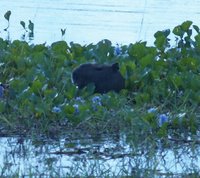
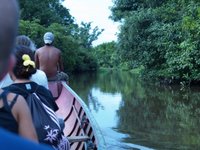 The next morning the 8 people in our tour group, along with the guide and two local fisherman went out on a boat for a look at the local wildlife. We saw thousands of differents birds, mainly waders and shore birds such at ibis´, spoonbills, egrets and herons. There were also capybaras (which look like guinea pigs about the size of a smallish labradour), multiple
The next morning the 8 people in our tour group, along with the guide and two local fisherman went out on a boat for a look at the local wildlife. We saw thousands of differents birds, mainly waders and shore birds such at ibis´, spoonbills, egrets and herons. There were also capybaras (which look like guinea pigs about the size of a smallish labradour), multiple  cayman alligators and even some river dolphins. After a few hours we pulled over and fished for pirrhanas, which are disturbingly easy to bait with chunks of raw beef. You pretty much throw the hook in the water and pull it back out trying to snag a fish on the way out. The fish that were caught were later fried up at camp
cayman alligators and even some river dolphins. After a few hours we pulled over and fished for pirrhanas, which are disturbingly easy to bait with chunks of raw beef. You pretty much throw the hook in the water and pull it back out trying to snag a fish on the way out. The fish that were caught were later fried up at camp  and I can attest that pirrhana is actually a very tasty dinner.
and I can attest that pirrhana is actually a very tasty dinner.
In the afternoon (as well as the afternoon of the following day) we went out hunting anaconda. Anacondas in this area have been seen as big as 9metres long. In order to find one, our guides take up pointed sticks and wade around in the swamps poking the mud. Apparently when you poke an anaconda it starts to move, you drop your stick, grab the snake and hope you get the right end (I was never really sure what the right end was.................). Luckily, or unluckily, we never managed to find an anaconda. Apparently it´s almost guaranteed in the dry months, but there is just too much water for them to lie in right now. I say luckily, because after a discussion on conservation with our guide, Elli, I´m not sure how I feel about the tourist trade out here.
Luckily, or unluckily, we never managed to find an anaconda. Apparently it´s almost guaranteed in the dry months, but there is just too much water for them to lie in right now. I say luckily, because after a discussion on conservation with our guide, Elli, I´m not sure how I feel about the tourist trade out here. 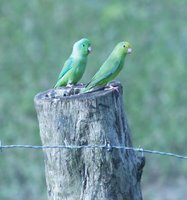
Apparently tourism has only become a big thing in the last 15 years out in Los Llanos. Elli has been working as a guide for 10 of these years, and in just a mere decade has seen a dramatic drop in the numbers of anacondas and birds. Anacondas are never killed by locals as they are actually quite harmless and help to control the local pest populations. But pulling them out of swamps, possibly injuring them in the process (Elli has seen snakes with broken jaws from being restrained) as well as the stress on the population during the all important breeding season that coincides with the influx of tourists, has managed to reduce their breeding success. Because it is such a fledgling industry out here, there is little to no control by the government and most tour groups are not working together to prevent these problems. We did see a small (maybe 2ft long) anaconda that a young boy was moving back to a local swamp from the road, which was enough for us.
has seen a dramatic drop in the numbers of anacondas and birds. Anacondas are never killed by locals as they are actually quite harmless and help to control the local pest populations. But pulling them out of swamps, possibly injuring them in the process (Elli has seen snakes with broken jaws from being restrained) as well as the stress on the population during the all important breeding season that coincides with the influx of tourists, has managed to reduce their breeding success. Because it is such a fledgling industry out here, there is little to no control by the government and most tour groups are not working together to prevent these problems. We did see a small (maybe 2ft long) anaconda that a young boy was moving back to a local swamp from the road, which was enough for us. 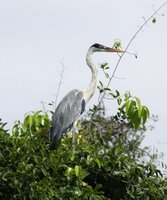
The next morning was spent horseback riding and admiring the birds and lazy cayman alligators, followed by more ¨safari-ing¨(riding around in the truck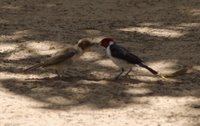 hoping to find anacondas). After another night in the hammocks we were back in our truck to head back to Merida. Happily, Gilles and I got dropped off just 4 hours up the road in Barinas, so that we could catch a bus to the Venezuelan border. Next stop - COLUMBIA!!!
hoping to find anacondas). After another night in the hammocks we were back in our truck to head back to Merida. Happily, Gilles and I got dropped off just 4 hours up the road in Barinas, so that we could catch a bus to the Venezuelan border. Next stop - COLUMBIA!!!
From Merida we signed up for a 4 day tour of an area called Los Llanos in the Amazonian basin of Venezuela. November is just the beginning of the dry season in this area. Los Llanos itself is a vast flatland covering about 1/3 of all of the land mass of Venezuela and is sparsely
 populated. It´s main source of revenue is the fact that it feeds about 5million of Venezuela´s 6.5 million cows. In the wet months it is almost entirely under
populated. It´s main source of revenue is the fact that it feeds about 5million of Venezuela´s 6.5 million cows. In the wet months it is almost entirely under water, and in the dry months can become almost completely parched with only a few bodies of standing water. The time of year we went was just the beginning of their ¨tourist season¨which lasts from about November 15 until March when the rains start again. Later on in the dry season it is much easier to see
water, and in the dry months can become almost completely parched with only a few bodies of standing water. The time of year we went was just the beginning of their ¨tourist season¨which lasts from about November 15 until March when the rains start again. Later on in the dry season it is much easier to see  wildlife (the main reason for visiting Los LLanos) as they congregate around the rapidly diminishing pools.
wildlife (the main reason for visiting Los LLanos) as they congregate around the rapidly diminishing pools.It´s a 12 hour ride from Merida sitting sideways in a
 all wheel drive vehicle as it crosses the spine of the Andes mountain range. A combination of very bendy roads, fast driving and altitude changes make for a slightly nauseating ride for the first 4-5 hours. The last few hours of the ride are on very muddy, rutted roads to get to the camp where we stay. The camp itself is quite rudimentary and run by a local farming family. There are a series of huts with several hammocks in each and a shower/bathroom area as well as a kitchen. There is no refrigeration and each tour group brings in its own food in from the outside. By the time we get there it is too dark to really appreciate our surroundings, except for the remarkable numbers of crickets, grasshoppers and various bugs that are attracted to the lights of the camp. Luckily, mosquito numbers are at a minimum (at least in comparison to Algonquin park in May, which is our set standard).
all wheel drive vehicle as it crosses the spine of the Andes mountain range. A combination of very bendy roads, fast driving and altitude changes make for a slightly nauseating ride for the first 4-5 hours. The last few hours of the ride are on very muddy, rutted roads to get to the camp where we stay. The camp itself is quite rudimentary and run by a local farming family. There are a series of huts with several hammocks in each and a shower/bathroom area as well as a kitchen. There is no refrigeration and each tour group brings in its own food in from the outside. By the time we get there it is too dark to really appreciate our surroundings, except for the remarkable numbers of crickets, grasshoppers and various bugs that are attracted to the lights of the camp. Luckily, mosquito numbers are at a minimum (at least in comparison to Algonquin park in May, which is our set standard). 
 The next morning the 8 people in our tour group, along with the guide and two local fisherman went out on a boat for a look at the local wildlife. We saw thousands of differents birds, mainly waders and shore birds such at ibis´, spoonbills, egrets and herons. There were also capybaras (which look like guinea pigs about the size of a smallish labradour), multiple
The next morning the 8 people in our tour group, along with the guide and two local fisherman went out on a boat for a look at the local wildlife. We saw thousands of differents birds, mainly waders and shore birds such at ibis´, spoonbills, egrets and herons. There were also capybaras (which look like guinea pigs about the size of a smallish labradour), multiple  cayman alligators and even some river dolphins. After a few hours we pulled over and fished for pirrhanas, which are disturbingly easy to bait with chunks of raw beef. You pretty much throw the hook in the water and pull it back out trying to snag a fish on the way out. The fish that were caught were later fried up at camp
cayman alligators and even some river dolphins. After a few hours we pulled over and fished for pirrhanas, which are disturbingly easy to bait with chunks of raw beef. You pretty much throw the hook in the water and pull it back out trying to snag a fish on the way out. The fish that were caught were later fried up at camp  and I can attest that pirrhana is actually a very tasty dinner.
and I can attest that pirrhana is actually a very tasty dinner.In the afternoon (as well as the afternoon of the following day) we went out hunting anaconda. Anacondas in this area have been seen as big as 9metres long. In order to find one, our guides take up pointed sticks and wade around in the swamps poking the mud. Apparently when you poke an anaconda it starts to move, you drop your stick, grab the snake and hope you get the right end (I was never really sure what the right end was.................).
 Luckily, or unluckily, we never managed to find an anaconda. Apparently it´s almost guaranteed in the dry months, but there is just too much water for them to lie in right now. I say luckily, because after a discussion on conservation with our guide, Elli, I´m not sure how I feel about the tourist trade out here.
Luckily, or unluckily, we never managed to find an anaconda. Apparently it´s almost guaranteed in the dry months, but there is just too much water for them to lie in right now. I say luckily, because after a discussion on conservation with our guide, Elli, I´m not sure how I feel about the tourist trade out here. 
Apparently tourism has only become a big thing in the last 15 years out in Los Llanos. Elli has been working as a guide for 10 of these years, and in just a mere decade
 has seen a dramatic drop in the numbers of anacondas and birds. Anacondas are never killed by locals as they are actually quite harmless and help to control the local pest populations. But pulling them out of swamps, possibly injuring them in the process (Elli has seen snakes with broken jaws from being restrained) as well as the stress on the population during the all important breeding season that coincides with the influx of tourists, has managed to reduce their breeding success. Because it is such a fledgling industry out here, there is little to no control by the government and most tour groups are not working together to prevent these problems. We did see a small (maybe 2ft long) anaconda that a young boy was moving back to a local swamp from the road, which was enough for us.
has seen a dramatic drop in the numbers of anacondas and birds. Anacondas are never killed by locals as they are actually quite harmless and help to control the local pest populations. But pulling them out of swamps, possibly injuring them in the process (Elli has seen snakes with broken jaws from being restrained) as well as the stress on the population during the all important breeding season that coincides with the influx of tourists, has managed to reduce their breeding success. Because it is such a fledgling industry out here, there is little to no control by the government and most tour groups are not working together to prevent these problems. We did see a small (maybe 2ft long) anaconda that a young boy was moving back to a local swamp from the road, which was enough for us. 
The next morning was spent horseback riding and admiring the birds and lazy cayman alligators, followed by more ¨safari-ing¨(riding around in the truck
 hoping to find anacondas). After another night in the hammocks we were back in our truck to head back to Merida. Happily, Gilles and I got dropped off just 4 hours up the road in Barinas, so that we could catch a bus to the Venezuelan border. Next stop - COLUMBIA!!!
hoping to find anacondas). After another night in the hammocks we were back in our truck to head back to Merida. Happily, Gilles and I got dropped off just 4 hours up the road in Barinas, so that we could catch a bus to the Venezuelan border. Next stop - COLUMBIA!!!
No comments:
Post a Comment